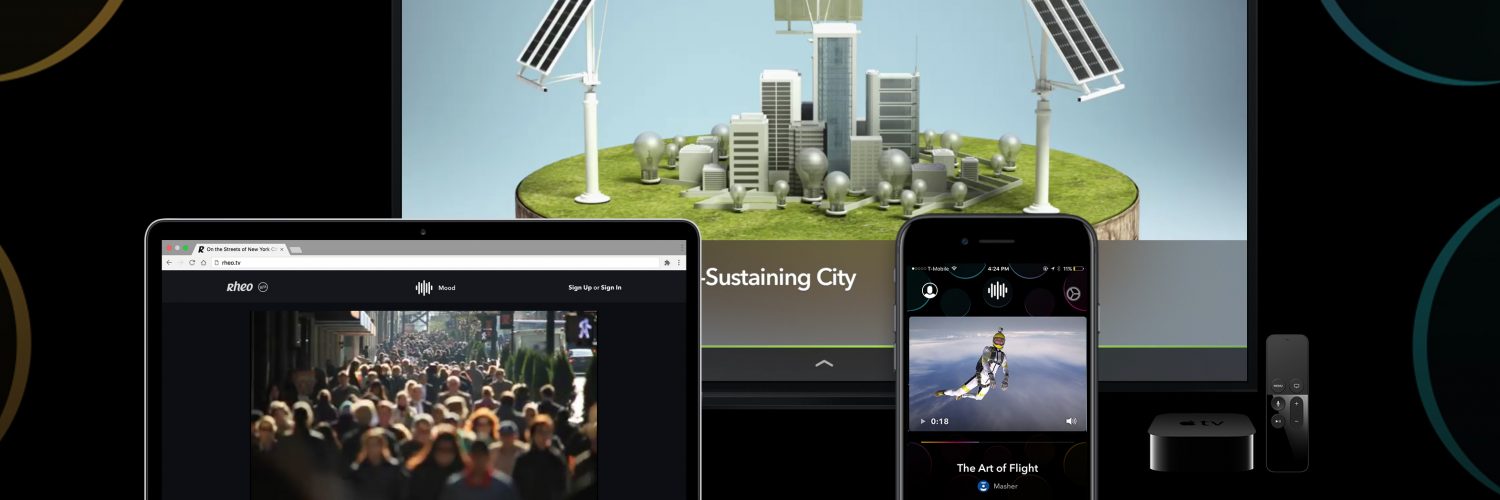It really does seem like choosing the right video or TV show to watch has become a chore. More choices means more inertia, and in the time it takes to finally settle on what you want to watch, you could have viewed three videos.
Solving for this is at the core of Rheo, a new social video platform that launched last week. Rather than sorting through different genres or what’s trending, Rheo serves up videos based on mood – Laugh, Inform, Learn, Taste, Chill, Move and Spark – and takes into viewer behavior, trends, and time of day. Viewers can also create their own channels, or easily navigate a stream of curated content.
Founders Alan Cannistraro and Charles Migos know a thing or two about content discovery and design: both worked at Apple building some of consumers’ favorite apps, including iBooks, Rmeote, and Apple News.
For more on Rheo and its take on video discovery we spoke with Cannistraro:
Found Remote: What’s broken with the video discovery experience and how does Rheo solve for this?
Alan Cannistraro: Discovery requires three things: variety, serendipity, and quality.
My belief in variety comes from years as a DJ. You need to take people on a journey, that changes and moves. Most discovery algorithms out there try to find a bunch of items that match as many criteria as the seed and play them one after another. Eventually you get bored and move on.
Serendipity is at the very core of our experience. You need to feel surprised when you see or hear something in order to feel like you discovered it. If you pick it from a list, it doesn’t surprise or delight you as much as when you tap into something that is already playing. Something is always playing in Rheo.
It’s amazing when you can stumble upon a needle in a haystack, but it’s rare. The songs, videos, TV shows and movies I’ve “discovered” that I love the most have already gone through some kind of vetting: a DJ picked it; a friend mentioned it off-hand; some critic reviewed it. To discover in a sea of everything is a crap-shoot. We need someone to help sift out the cruft so we can discover the old stuff.
FR: How is the experience more personalized than what YouTube already offers?
Cannistraro: Personalization, on its own, isn’t enough. We believe that the right content strategy needs curation and personalization that fit together. Discover Weekly from Spotify is heads above everything else in the consumer music experience because it fits both techniques together.
But since you asked, we’re personalizing along different dimensions. We are finding patterns in the type of content that people are watching at different times of day, and on different devices, and then serving it up when the time time is right for each individual. If you like news (“Inform”) in the morning, and comedy (“Laugh”) in the evening, then that’s what Rheo is. I spend my weekends listening to music and watching short films and art in the wee hours, so my Rheo has learned to become that for me without any effort on my part.
FR: Why is mood a good basis for viewing?
Cannistraro: Moods are primal. Our emotional brains are 100 million years older than our logical brains. We can discern how we feel much faster than we can decide what we want. This is especially applicable when you just want to watch media, but you don’t know exactly what. In the time it takes for logical you to work out what app, channel, brand, and clip you want to watch and pick it, the emotional you could (should) have already enjoyed three great clips.
FR: How does original content fit into Rheo?
Cannistraro: There are business reasons we may want to consider it in the future, but for now, we believe that there is already enough great content in the world. We wouldn’t be adding anything to the world by making something you can’t get outside of Rheo. Instead, we want to make sure the great stuff that is already getting made is getting to you.
That said, we’re very proud of the social dynamic that we’ve released with Rheo. With Reactions, you have a video-first way of communicating with others about what you’re watching, learning, and enjoying every day. With your Reel, you become the host of your very own video channel. That interplay between you and the content is original, and only available on Rheo.
FR: Your leadership team has worked on some of the most widely used products, from iBooks to Apple News to Facebook’s News Feed — how will that UI and UX expertise fuel what you build at Rheo moving forward?
Cannistraro: I’ve worked at two amazing companies, and I’ve learned two incredibly powerful, but opposing ways of building products. Apple believes intuition and beauty are the seeds to building loyal connections with their users. Facebook believes that small improvements, compounded, will eventually supersede all else. Both are incredibly powerful ideas, and both very successful. I think in order to compete against either, you need to understand and be great at both.
The problem with the video space is that the big players are the ones who are hyper-focused on data, and not on user experience. So there’s a hole that has been left open. Our biggest opportunity is to step in and build a product that people really, really love. A video is a very powerful form of communication, but for us, the experience is the medium. You should be able to move through digital information as quickly as your mind can perceive it and your body can react to it.
We also think that there is room to innovate on user experience when it comes to monetization. The current model of interrupting you with ads is a painful experience. We have ideas for something that feels much better.
Mobile phones were around for years before 2007, but it took a phone built to be reconsidered with an amazing user experience in mind to make the industry take off, and see users willingly pay to get it. The transition from old media to media is happening, but it’s been dragging on for a long time. Digital video revenues are still only 10% of linear. That’s got to flip, and it’s slowly happening, but consumers are taking their damn time. We think it’s because they haven’t found something they love yet.
Creating a great experience for people is the way we stand-out. That is our thesis, and is what drives us obsessively every day.





















